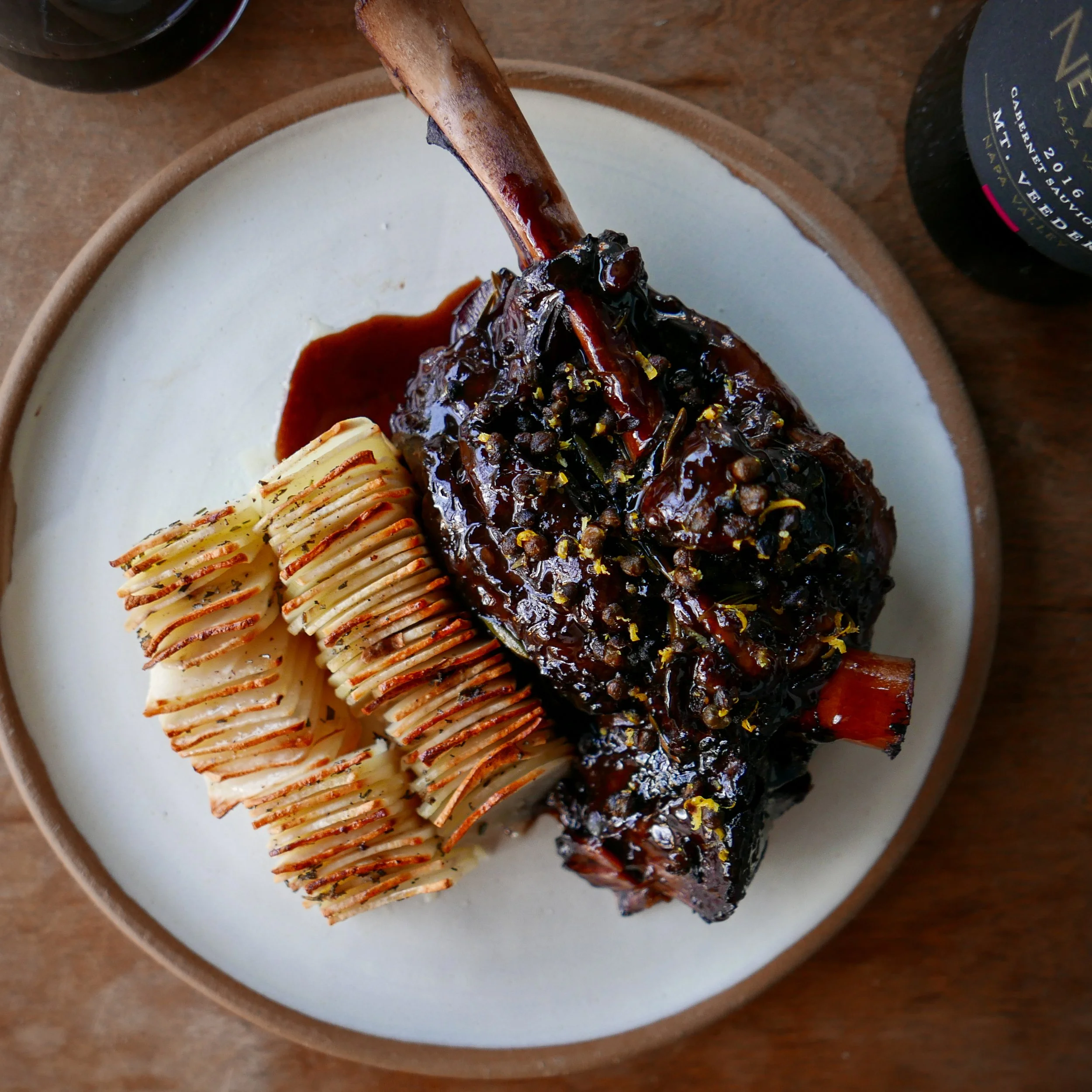braised lamb shank with fried capers, meyer lemon and herbed domino potatoes
The ingredients and presentation may change, but this classic braising technique stays true as the foundation. With all the recipes, technology and ideas behind cookery readily available to us nowadays, this way to braise is a safe place to always come home to. A simple wintery recipe like this is the perfect way to celebrate a special wine, like Newton’s Mt. Veeder Single Vineyard Cab Sauv. Notes of dark fruit, blackberries, mushroom and leather set the stage for this simple, but loved dish to create memories at the table with a breath of elegance. I love all the Newton wines, as organically farmed and cared for grapes speak my language.
Serves 2 hungry folks
Prep time - 30, Cook time 3-4 hours
Ingredients
2 bone in lamb shanks
Salt
A dusting of all purpose flour
Extra Virgin Olive Oil (EVOO)
1 yellow onion - diced
1 large carrot - diced
2 stalks - diced
4 cloves of garlic - lightly smashed
2 bay leaves
2 sprigs rosemary
1 cup red cooking wine
3 cups beef, chicken or vegetable stock
For the potatoes:
2 medium/large yukon gold potatoes
3 tablespoons unsalted butter
Salt
1 teaspoon chopped fresh thyme
For the garnish:
2 tablespoons capers
Extra Virgin Olive Oil
1 Meyer lemon for zest
Method
Preheat the oven to 325°F. Pat the lamb shanks dry with a paper towel and season heavily with salt. Sprinkle a bit of flour into a dish and toss the seasoned lamb shanks around in the flour until a light, even dusting is achieved. Pat off excess flour and transfer to another plate or dish. Heat a large dutch oven on the stove to high heat with a heft drizzle of EVOO. Sear the lamb shanks in the hot oil on all sides until well caramelized and dark golden brown on all sides. Turn off the heat and remove the shanks and set aside. Carefully drain the lamb oil from the pan and replace with a fresh drizzle of EVOO. Bring the dutch oven back to high heat and add the onion, carrot, celery, garlic, bay leaves and rosemary. Season with salt and stir occasionally until sizzling and aromatic (3-4 minutes). Add the red wine, bring to a boil, and allow it to reduce for 4-5 minutes. Add in the beef stock, bring to a boil, then replace the lamb shanks. Nestle the lamb shanks into the liquid and veg so that they’re at least half submerged. Add more stock if needed - ideally the liquid will cover ⅔ of the shanks. Bring the entire dutch oven to a boil, immediately reduce to a simmer then cover with parchment, tucking it in around the shanks. Place the lid over the top of the dutch oven (or tight foil) and place in the 325°F oven. Allow the shanks to cook for ~3 hours, or until falling off the bone.
While the shanks are braising, prepare the domino potatoes. Trim the potatoes into rectangles, doing your best to minimize waste and maximize the amount of potato, while removing the majority of the skin. Slice the rectangles into domino shapes on a mandolin directly into a bowl of cold water. Rinse the potatoes under running cold water, drain, and set aside in a mixing bowl. Melt the butter with the chopped thyme and a few pinches of salt. Transfer the melted butter to the sliced, drained potatoes and toss well. Transfer the butter coated potatoes to a small baking dish, one at a time, carefulling lining them up to be stacked tightly next to each other. Scrape any excess butter from the bowl over the top of the potatoes and bake in the oven with the lamb shanks for 60-90 minutes or until potatoes are soft in the center and crispy on the top. You may want to broil the potatoes to brown the tops before serving.
Once the lamb shanks are fork tender and falling off the bone (3-3 ½ hours) remove from the oven and allow to cool slightly in the braising liquid. Occasionally baste the braise shanks with the liquid while cooked.
To make the fried capers start by placing the capers on a paper towel lined small tray or plate to dry. Bring a pan with a thin, even layer of extra virgin olive oil to medium high heat. Test the heat with a small flick of water; the oil should sputter rather violently immediately. Add in the capers and stir or shake the pan occasionally to make sure they’re frying evenly. Once the sputtering and bubbling subsides, remove from the pan with a slotted spoon and transfer to the paper towel lined tray to cool and absorb excess oil. Transfer to a dry, paper towel lined environment until serving.
To turn the braising liquid into a glaze, set the shanks aside and strain the liquid through a fine mesh strainer into another large pan. Discard the vegetables and herbs and bring the liquid to a boil. Place the shanks into the bubbling liquid and begin to baste the shanks with the liquid while it reduces. At this point, reduce to a heavy simmer and add a tablespoon or so of butter to help make the glaze nice and glossy. Once the shanks are glazed and the reduced liquid becomes tight, it’s ready. Taste and adjust seasoning if needed.
Broil the potatoes just before season and finish with a pinch of salt. Plate with the lamb shanks and a few spoonfuls of the glaze over the top of the shank. Finish with a sprinkling of the fried capers and meyer lemon zest. Enjoy with an amazing cabernet and someone you love.

